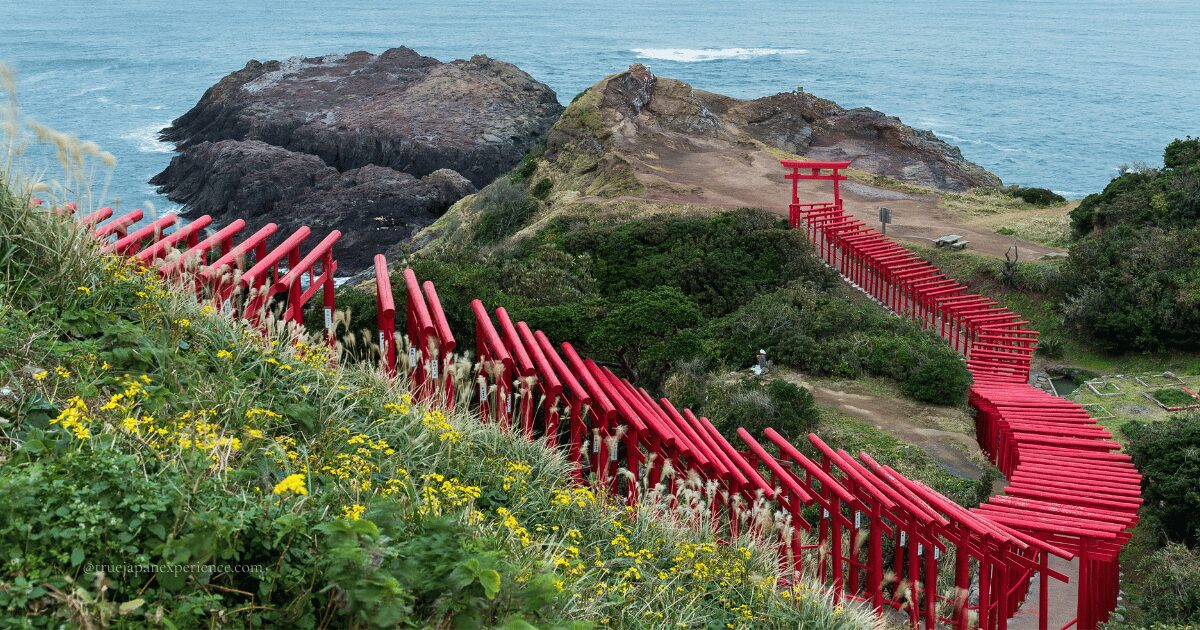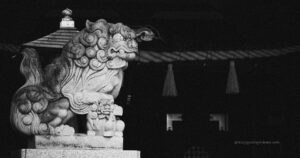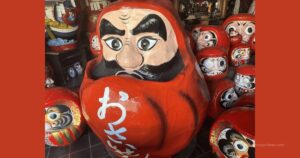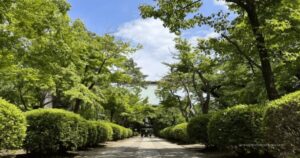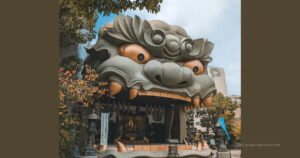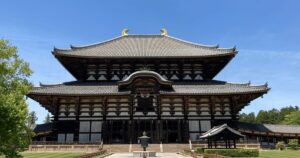When you visit a Shinto shrine in Japan, the first thing you often see is a big gate called a Torii. But what is the Torii gate meaning?
Maybe you have also asked yourself: why are so many Torii gates red? Or why do Torii gates come in different colors and shapes?
This article will simply explain the Torii gate meaning. You will learn what Torii gates mean, their colors, shapes, and history.
Knowing the Torii gate meaning will make your next trip to a shrine even more fun and interesting!
What Is a Torii? The Meaning of Torii at Shrines
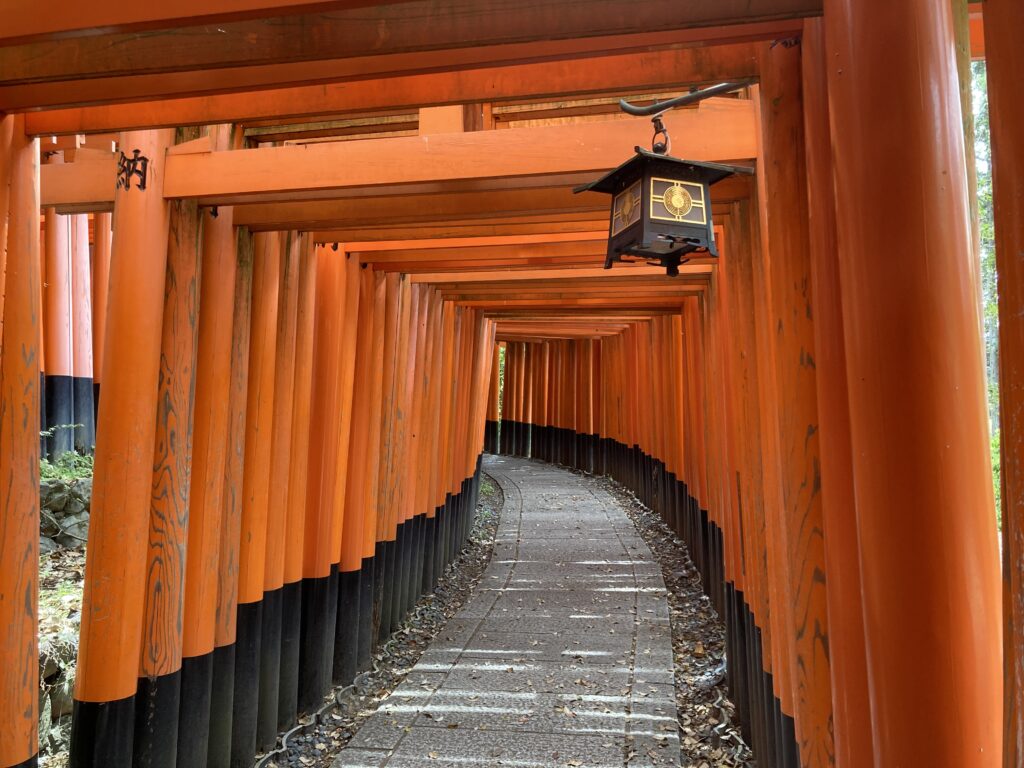
A Torii gate is a traditional gate you see at the entrance of almost every Shinto shrine in Japan.So, what is the Torii gate meaning?
This special gate shows where the normal world ends and the sacred space of the gods (called kami) begins. People believe that the area inside the Torii is holy and protected by the gods, while the area outside is just part of everyday life.
The Torii acts like a border, or a “barrier,” to keep out things that are not pure. Passing through the Torii means you are leaving behind any bad things or worries from daily life.
Walking under a Torii is also a way to show respect before stepping into a place where gods are honored. In this way, the Torii helps you get ready in your heart and mind to pray or make wishes.
Some people say the Torii also keeps out bad luck or evil from the sacred place. Visitors feel that passing under this gate makes their hearts cleaner, so they can face the gods with a fresh feeling.
How to Respectfully Walk Through a Torii Gate
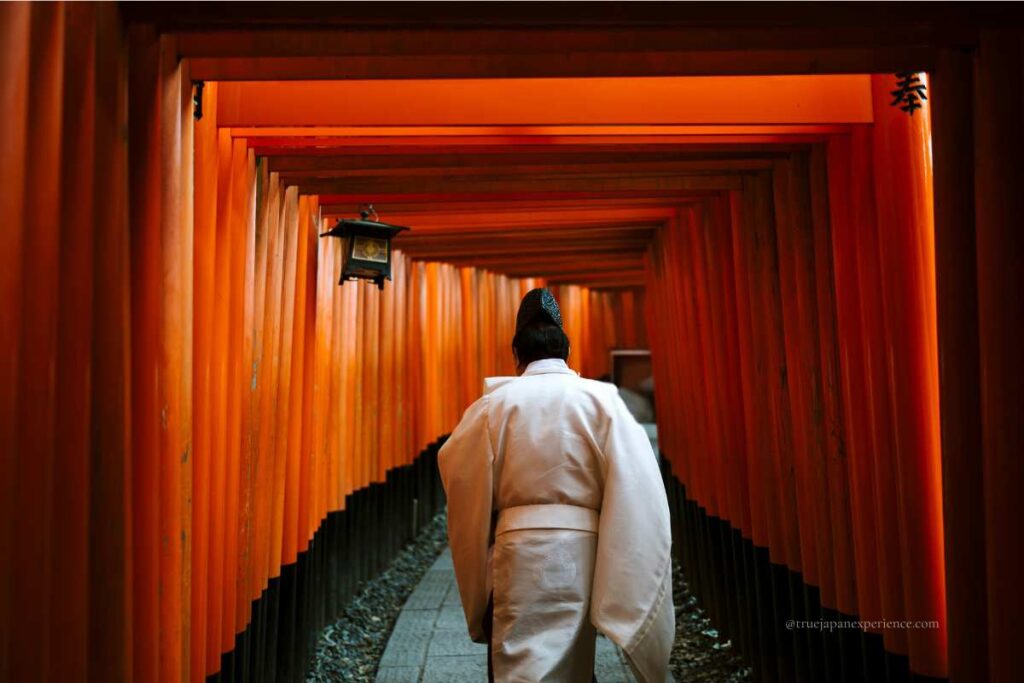
When you visit a shrine, there are simple manners people follow when going through the Torii:
Bow once before you walk under the Torii. This shows respect to the gods you are about to meet.
Avoid the center path of the gate when you walk through. The center is thought to be the path for the gods, so most people use the left or right side.
When you finish your visit and leave the shrine, turn to the Torii and bow again before you leave. This is a way to say thank you for your visit.
Following these simple steps shows your respect for the sacred place and its traditions. Even people who are not religious often do this at shrines in Japan.
The Origin of the Torii Gate: Myths and History
The true origin of the Torii gate is a mystery, but many stories and ideas explain where it came from:
No matter the exact origin, the Torii gate always marks a boundary between the human world and the sacred world.
Why Are Torii Gates Red? The Power of Vermilion
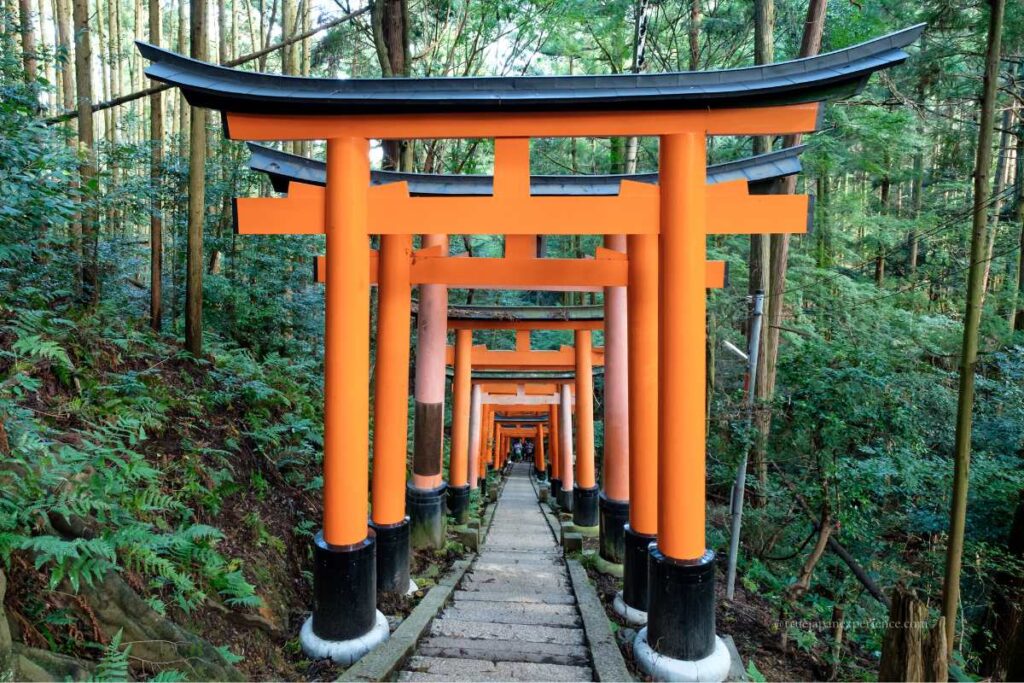
You may have noticed that many torii gates are painted a vibrant red, also known as vermilion. But What is the meaning of the red color on a Torii gate?
Many Torii gates are red for several important reasons:
・To keep away bad spirits
・To bring energy and life
・To protect the wood
・The red color became a tradition long ago
Let’s look at each reason in more detail.
In Shinto belief, red is a color that can stop evil spirits and bad luck. People think it acts like a strong shield, protecting the shrine and its visitors from harm. This is why red Torii gates are often seen as a guardian of safe and peaceful places.
Red is also connected to bright things like the sun and fire. These are symbols of energy, power, and life in Japanese culture. So, the red color of Torii gates is like a symbol of strong life force, helping to bring a lively and sacred feeling to the shrine.
The red paint used on many Torii gates contains a special mineral called cinnabar. This mineral helps protect the wood from rotting and bugs. Because Japan has a humid climate, this protection is very important to keep the gates strong and lasting a long time.
The red color became popular during the Heian to Edo periods, about 1000 to 1800 years ago. This was a time when Shinto beliefs mixed with Buddhism, and red became a sacred color for many religious buildings. So, painting Torii gates red became a tradition that spread all across Japan.
By understanding these reasons, you can see that the red color of Torii gates is full of meaning, not just a pretty color!
Torii gates come in more colors than just red: What do the other torii gate colors mean?
While many people think of Torii gates as red, not all of them are the same color.
Depending on the shrine and local customs, you can find Torii gates in different colors.
Each color has its own special meaning and shows something unique about the shrine’s history and beliefs. Let’s explore the different colors you might see and what they mean.
Natural Wood Torii
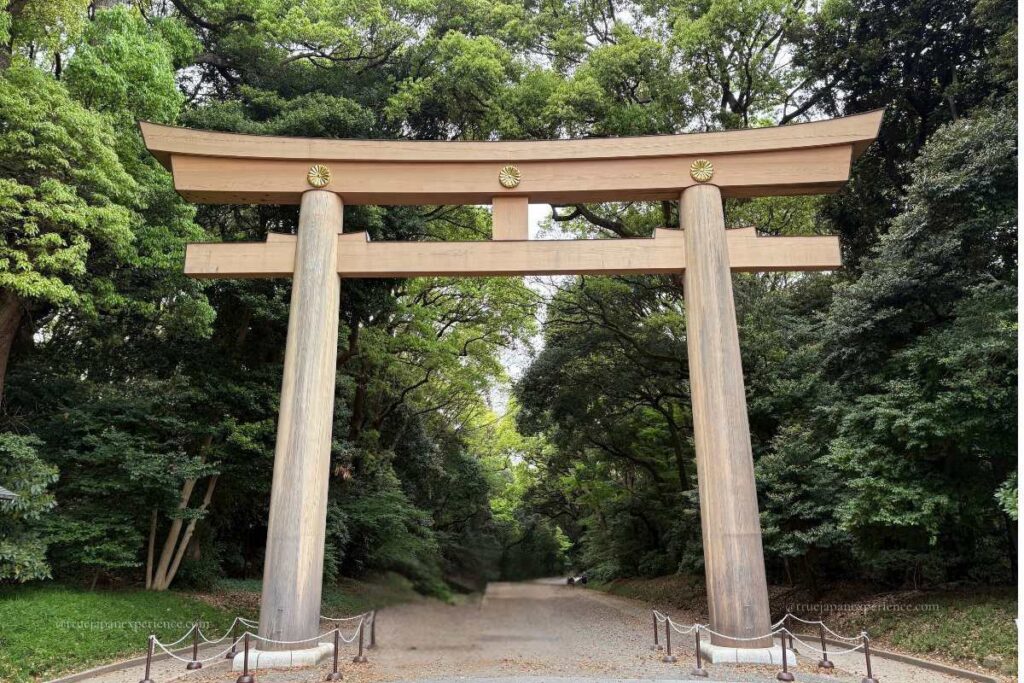
Many Torii gates you see painters often paint red, but some shrines use natural wood and leave their gates unpainted.
Shrines that have high status and special meaning in Japan often choose natural wood gates.
For example, Ise Grand Shrine, which is connected to the Japanese Imperial family, chooses natural wood Torii. Another example is Meiji Shrine in Tokyo, where builders use big, unpainted wood for the main Torii.
These unpainted Torii show respect for tradition and nature. They symbolize purity and the sacredness of the shrine. Using natural wood also keeps the original look of the wood, which many find beautiful and special.
Natural wood Torii are typical of shrines with strong ties to the imperial family or important historical backgrounds, rather than just by their age.
One of the best-known examples of a natural wood torii is at Meiji Jingu Shrine in Tokyo. Surrounded by a lush forest, its massive wooden gates create a calm and sacred atmosphere. Discover more about this peaceful spot here:
👉 Visiting Meiji Jingu Shrine: A Sacred Forest in the Heart of Tokyo
Black Torii
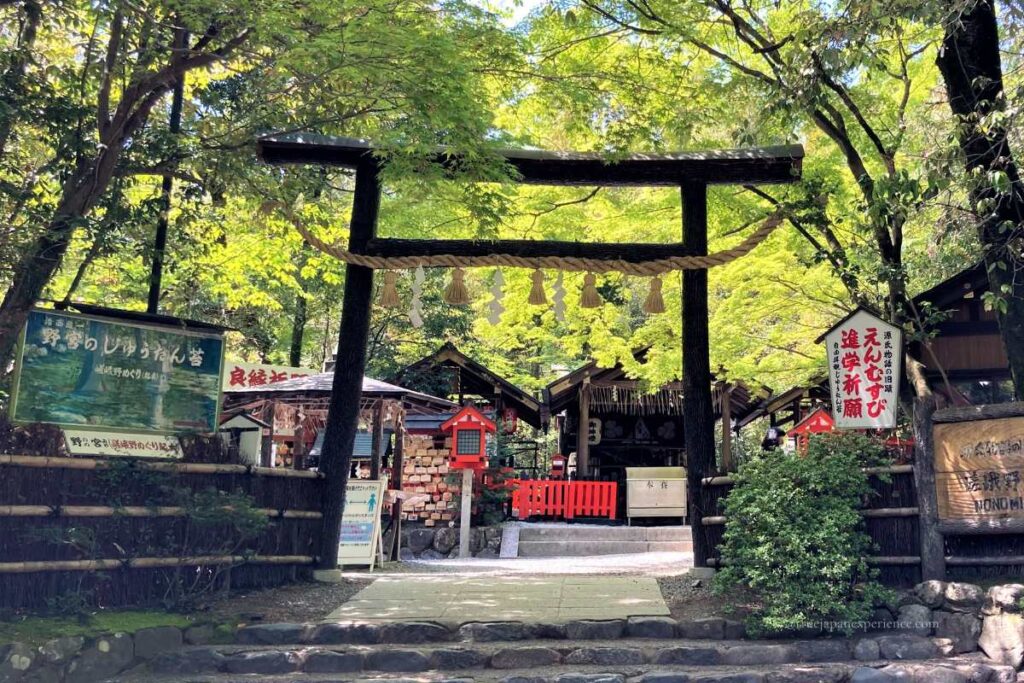
Black Torii gates sometimes serve special purposes. People believe black keeps evil spirits away and stops bad luck.
Some shrines choose black as the main color to honor a certain god or to match their style and history. Builders use a special type called “Kuroki Torii,” which uses wooden logs with the bark still on. This style gives the gate a dark and natural look. You can find this type at places like Nonomiya Shrine in Kyoto.
Old beliefs say the color of a Torii can depend on the direction it faces. Black represents the north and connects to “Genbu,” a magical turtle that guards that direction. For example, the north gate at Shōin Shrine is black because of this reason.
So, if you see a black Torii, it might be there for protection, for symbolism, or to match a special direction. Each color at a shrine has its own story and deeper meaning.
Nonomiya Shrine in Kyoto is especially famous for its rare black torii, made from unpeeled logs. It is also known as a power spot for love and has ties to The Tale of Genji.
👉 Learn more about Nonomiya Shrine and its black torii (Japanese only)
Other Colors of Torii Gates

Some shrines have Torii gates painted in colors other than red, black, or natural wood. In addition to the well-known red gates, you can sometimes find gold, blue, white, pink, or even other creative colors across Japan.
Shrines often choose colorful Torii gates to match the local scenery, celebrate special events, or make the shrine stand out and attract visitors.
Each color tells its own story and meaning for that shrine. For example, Mikane Shrine in Kyoto uses gold Torii gates because people there pray for wealth and good luck.

Blue Torii gates are rare, but appear at shrines connected to water gods. They give a cool, quiet feeling.
Some shrines also have white Torii gates. White Torii stand for purity, cleanliness, and start of something new.
Directions and Torii Colors
There is a special idea in Japan that the color of a Torii gate can be chosen based on the direction it faces. This is based on four myth animals, each guarding a direction:
Black suits gates facing north because it stands for Genbu, a turtle spirit that protects the north.
People often paint gates blue when they face east, to honor Seiryu, a blue dragon.
Red usually fits gates facing south, because it connects to Suzaku, the red bird.
White matches gates facing west, as it symbolizes Byakko, the white tiger.
Not every shrine follows these rules, but some choose these colors to protect the shrine from all directions.
What Are the Four Guardians?
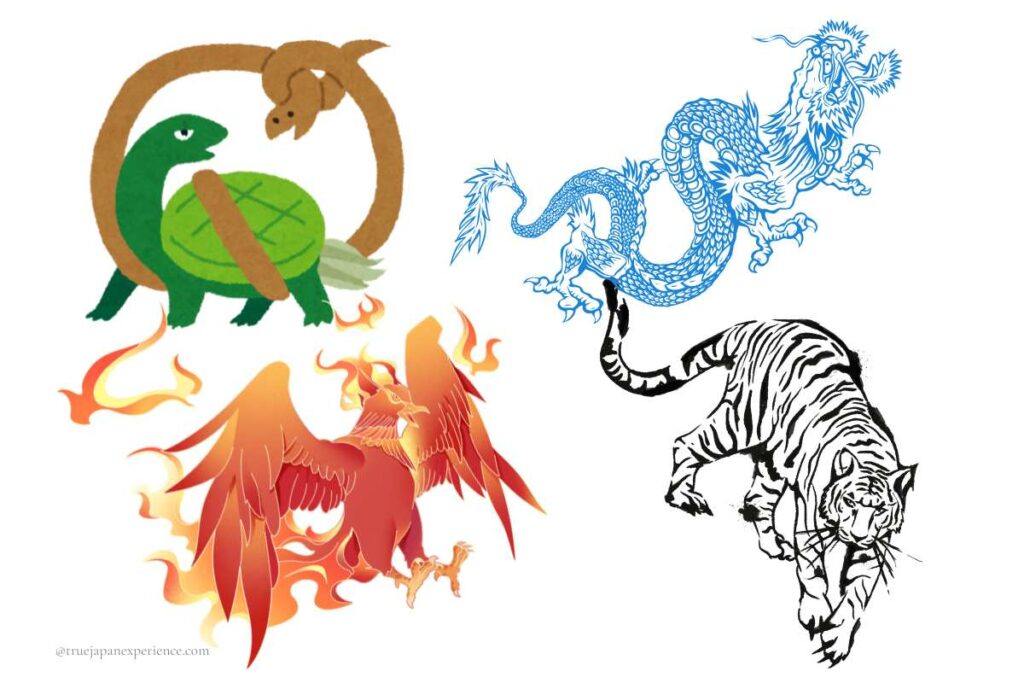
In old stories from China, there are four special guardian animals called the Four Gods or Four Spirits. They protect the four directions: north, east, south, and west. Each guardian has its own color and meaning.
This idea later came to Japan and became a part of Japanese culture too. Now, these four animals are used in many places in Japan, like shrines, to show protection and good energy.
・Genbu (玄武) is a turtle mixed with a snake. It protects the north and is believed to bring long life and safety.
・Seiryu (青龍), a blue dragon guarding the east, is strong and thought to bring good luck and success.
・Suzaku (朱雀) looks like a red bird with wide, beautiful wings. Watching over the south, it brings happiness and keeps bad things away.
・Byakko (白虎) takes the form of a white tiger that watches the west. It scares off evil and helps bring good health and fortune.
These four animals are very important in old stories and beliefs. They watch over the land and keep people safe.
The color and direction make each Torii and shrine very interesting to see and learn about!
Different Shapes of Torii: Recognizing Types and Their Stories
There are many shapes of Torii gates across Japan. The two main types are:
Shinmei Torii: Simple and straight lines without curves. Usually unpainted. Found in famous shrines like Ise Grand Shrine.
Myojin Torii: Curved and more decorative, often painted red. Seen in many shrines, including Fushimi Inari Shrine in Kyoto.
After all, the most famous example of Myojin Torii is found at Fushimi Inari Shrine in Kyoto. Thousands of red gates create a magical tunnel leading up the mountain. If you want to learn more about this iconic place, check out our full guide here:
👉 Fushimi Inari Taisha – Kyoto’s Shrine of Foxes and Torii Gates
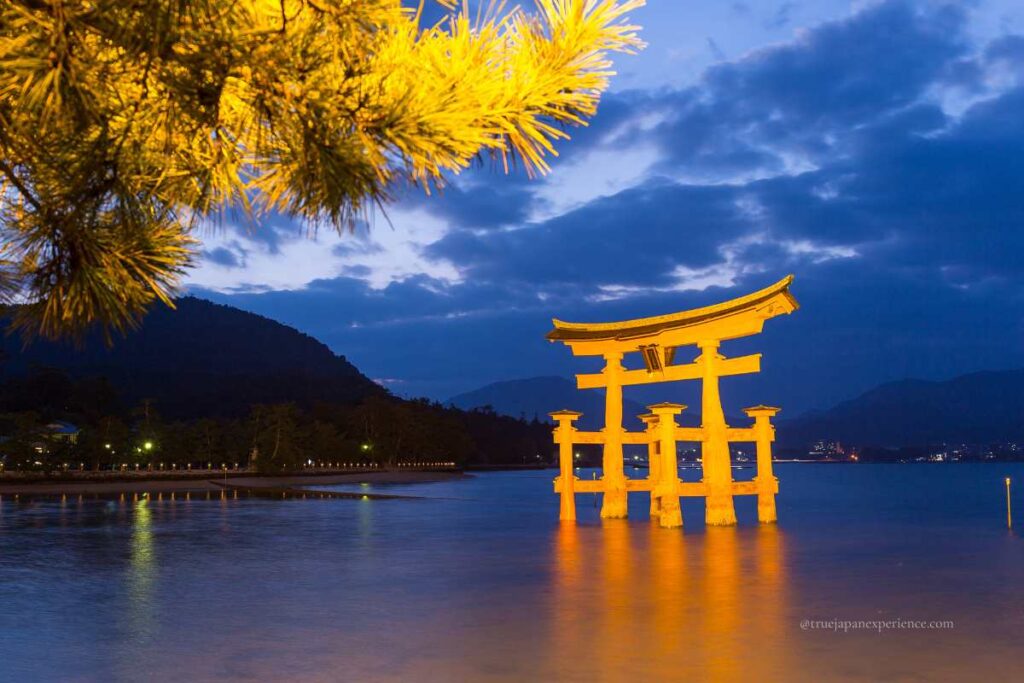
Other types you might see:
・Ryobu Torii: Has extra support pillars.
・Kasuga Torii: Known for crossed bars and a special design.
・Miwa Torii: A rare type with three pillars.
Each shape reflects the shrine’s origin and style, telling a story about the religion and the people who built it.
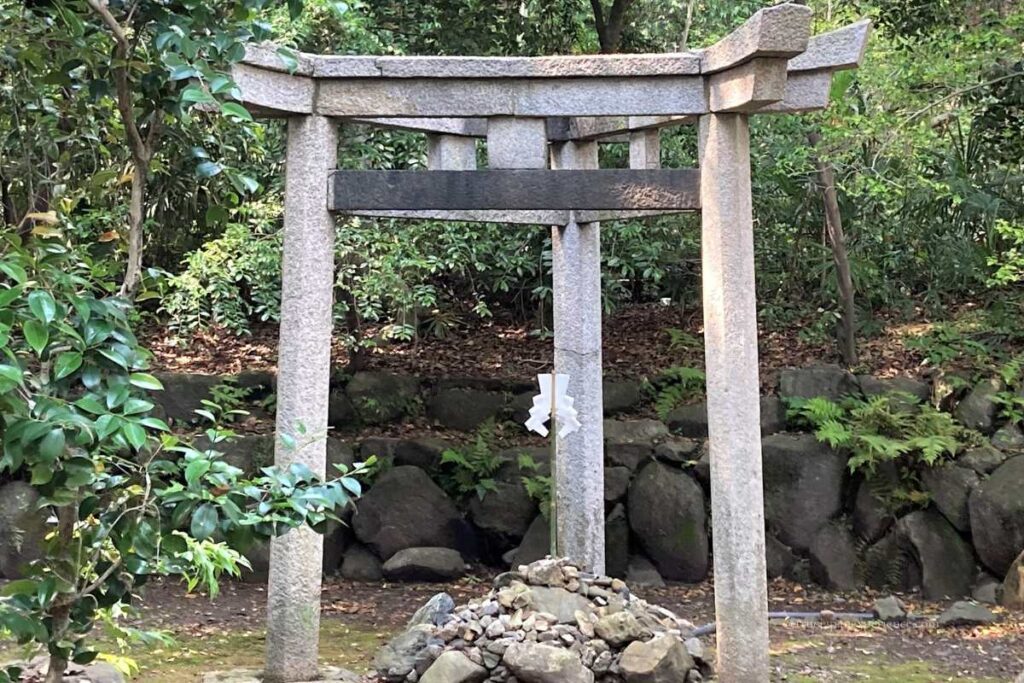
The most famous Ryobu Torii stands in the sea at Itsukushima Shrine on Miyajima Island. This “floating gate” is one of Japan’s most iconic sights and a must-visit for travelers. Learn more in our guide here:
👉 Itsukushima Shrine and Miyajima Island: Floating Torii Gate Travel Guide
Miwa Torii is extremely rare, and one unique example is the “Three-Pillar Torii” at Kaiko no Yashiro in Kyoto.
👉 Learn more about the mysterious Sanbashira Torii here (Japanese only)
Summary: The Meaning of Torii Gates Is a Window Into Japanese Culture
Torii gates are not just red wooden gates. They are symbols full of meaning, history, and culture. The color, shape, and stories behind each Torii show you how important the shrine is and what kind of gods live there.
Next time you see a Torii gate, remember it is a special door between the everyday world and the sacred.
Learning about the Torii gate meaning makes visiting shrines a richer and more special experience.
